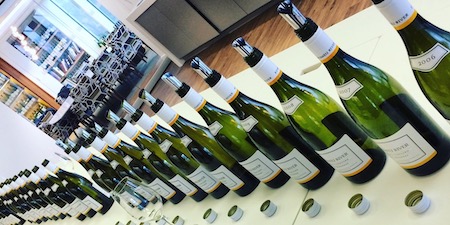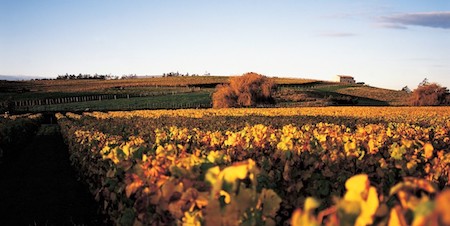Top of the World: The Consistently Stunning Kumeu River Chardonnays
The recent vertical tasting at the offices of Farr Vintners in London of every dry white chardonnay that Kumeu River in Kumeu, New Zealand, has bottled since the 2006 vintage was a remarkable demonstration of the consistent high quality and striking cool-climate style of this producer. That Kumeu River produces some of the world’s best chardonnays won’t come as a surprise to their loyal followers around the world, but for a wider audience it’s big news. It also affirms what we discovered in our recently published, countrywide report of Kiwi wines.
The reasons for the surprise begin with the widespread perception that New Zealand wine is all about crisp and aromatic sauvignon blanc. This grape variety now accounts for 61% of the nation’s almost 38,000 hectares of vineyards, but due to the often rather high yields, this rises to 75% when considered in terms of actual production — on average, a quarter of a billion bottles of sauvignon blanc per year.
By contrast, chardonnay accounts for just over 8% of New Zealand’s vineyards. Although globally chardonnay production has boomed during the first two decades of the 21st century, with the area planted increasing considerably in countries as diverse as France, Italy, the USA and Chile, in New Zealand the area planted with the grape has actually fallen from 3,911 hectares in 2009 to 3,163 hectares as it currently stands. No wonder the nation’s chardonnays struggle for recognition around Planet Wine.

Our Contributing Editor Stuart Pigott travelled to London for a Kumeu River tasting hosted by Farr Vintners in September 2018. We rated every chardonnay bottled by the famous New Zealand estate since 2006.
Counting 30 hectares of estate vineyards and 10 hectares worth of grapes supplied by local growers under long-term contracts, Kumeu River, situated just north of Auckland on the North Island, produces an average of 250,000 bottles per year, not one of which is sauvignon blanc. This is enough for global distribution, particularly with regards to the Estate Chardonnay, but they are spread quite thin, and pretty much wherever you live you’ll need to make an effort to buy them. For this reason alone, Kumeu River is an exception to the NZ wine rule.
However, as the Farr Vintners tasting revealed, other more important things make the Kumeu River chardonnays truly exceptional, not least the way every vintage since 2006 produced only wines worthy of 90 points or more. The wines also mature beautifully, retaining their youthful freshness for at least five years, a slow aging curve that’s assisted by the screw cap closure used for all of these wines.
On that point, there’s a striking contrast to the situation in chardonnay’s home region of Burgundy. For more than a decade, producers there have been struggling with the “premox” problem, aka premature oxidation. It results in the sudden and catastrophic development and deterioration of three- to six-year-old wines that a generation ago could age for one or more decades in bottle. So far, there is no scientific explanation for premox, nor have non-scientific methods such as biodynamic cultivation of the vineyards solved the problem. Not one of the 48 Kumeu River chardonnays in the tasting was too mature; in the fact, all four 2006 wines were delicious! As Kumeu River Marketing Director Paul Brajkovich explained, “With age, they flesh out and you get a plush character.” That’s what high-end chardonnay should do.
Even so, it was among the vibrant young wines (the 2013-2017 vintages) where the unique style of Kumeu River was most strikingly apparent. These are cool-climate chardonnays with moderate alcohol and quite pronounced acidity, which accentuates the brightness of the aromas. Sliced pears, white peaches and various types of citrus fruit are the most pronounced aromas, the emphasis shifting from one of those to the other depending on the vintage. Many wines also have a mineral character reminiscent of wet stones.

The estate of Kumeu River shares its name with the river running through the small town of Kumeu, located a short drive north of Auckland. Compared to Burgundy’s Cote d’Or, the climate is cooler and wetter.
In an average year at Kumeu, the summer highs only just top 30 degrees Celsius, with most warm days in the 26–30 range. Because they are slow to warm, the rather heavy clay soils accentuate the cool climate. Kumeu is quite a bit cooler than the famous vineyards of Burgundy’s Cote d’Or and also has higher average rainfall, but it was Burgundy that supplied the model for the Brajkovich family’s chardonnays.
“We’ve been making this style of chardonnay since 1985,” says Paul Brajkovich. However, there are a number of important differences in winemaking to the norm in Burgundy. “Our grapes are always whole-cluster pressed, undergo wild fermentation and spend 11 months on the full lees,” he explains.
The latter two techniques are normal for high-end wines in chardonnay’s homeland. However, whole-cluster pressing isn’t common in Burgundy (unlike Champagne where it is standard) and this undoubtedly accentuates the sleek personality of the Kumeu River wines. At Kumeu River, 20% new oak is used for the Estate Chardonnay and just 25% for the three single-vineyard wines. That modest percentage means the terroir character comes through very strongly.
The 2.6-hectare Mate’s Vineyard, named after Mate Brajkovich, the father of winemaker Michael and his brother Paul, is the oldest of Kumeu River’s chardonnay plantings dating back to 1990. The first vintage of Mate’s Vineyard was 1993, one year too late for its namesake to experience. Meanwhile, 2006 was the first vintage of the Coddington (a non-estate vineyard) and Hunting Hill (a three-hectare estate vineyard) bottlings, so the tasting included every vintage made of those two wines.
Mate’s Vineyard gives the most concentrated and powerful wines, while Hunting Hill, which lies higher up on the same slope, produces more steely and mineral expressions with the best aging potential; Coddington is more generous and fleshy. “We’ve bought the Kumeu River chardonnays since 1989,” says tasting organizer Stephen Browett, Chairman of Farr Vintners. “Hunting Hill is usually our favorite, but the Estate Chardonnay is great value for money.” Compare the price of that wine with white Burgundies in your market, look at our ratings, and then you’ll understand why we agree with him. — Contributing Editor, Stuart Pigott